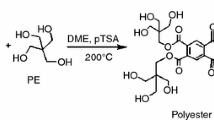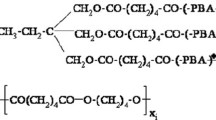Abstract
A new kind of water-soluble hyperbranched unsaturated polyester resin (HBUP) was prepared to enhance the rate of curing, to increase the adhesive strength and to decrease the dielectric constant of the water-soluble insulating impregnation coating comprising water-soluble unsaturated alkyd resin and amino resin. The HBUP was synthesized from pentaerythritol as the core molecule, which was then esterified with dimethylol propionic acid (DMPA). In addition, the terminal hydroxyl groups of HBUP were modified by acrylic acid and maleic anhydride. The hyperbranched structure and C=C double bonds of HBUP resin were investigated by Fourier transform infrared (FTIR) and nuclear magnetic resonance (13C-NMR and 1H-NMR) spectroscopies. The reaction rate of the water-soluble insulating impregnation coating was accelerated by addition of HBUP which was demonstrated by the surface drying test and differential scanning calorimetry (DSC). The electrical and mechanical properties of the water-soluble insulating impregnation coating were also studied. It was shown that the addition of HBUP resin could reduce the permittivity of the coating which was at its lowest level when the HBUP content was 5 wt%, whereas the breakdown voltage, volume resistivity and adhesive strength of the coating were improved.















Similar content being viewed by others
References
Shah MY, Ahmad S (2012) Waterborne vegetable oil epoxy coatings: preparation and characterization. Prog Org Coat 75:248–252
GudimYA Zinurov IY (2014) Development of the process of electric steel production and methods for improving the technical-and-economic indices of electric arc furnaces. Russ Metall 6:427–431
Dhevi DM, Prabu AA, Pathak M (2014) Miscibility, crystallization and annealing studies of poly (vinylidene fluoride)/hyperbranched polyester blends. Polymer 55:886–895
Buonocore GG, Schiavo L, Attianese I, Borriello A (2013) Hyperbranched polymers as modifiers of epoxy adhesives. Compos B Eng 53:187–192
Suzuki T, Miki M, Yamada Y (2012) Gas transport properties of hyperbranched polyimide/hydroxy polyimide blend membranes. Eur Polym J 48:1504–1512
Kou H, Asif A, Shi W, Jiang Z, Huang W (2004) A novel hyperbranched polyester acrylate used for microfabrications. Polym Adv Technol 15:192–196
Asif A, Huang CY, Shi WF (2003) UV curing behaviors and hydrophilic characteristics of UV curable waterborne hyperbranched aliphatic polyesters. Polym Adv Technol 14:609–615
Şabani S, Onen AH, Güngör A (2012) Preparation of hyperbranched polyester polyol-based urethane acrylates and applications on UV-curable wood coatings. J Coat Technol Res 9:703–716
Hölter D, Burgath A, Frey H (1997) Degree of branching in hyperbranched polymers. Acta Polym 48:30–35
Mohebl K, Ebrahimi NH (2015) Preparation and rheology characterization of branched polypropylene during reactive extrusion process. Iran Polym J 24:309–316
Ratna D, Simon GP (2010) Epoxy and hyperbranched polymer blends: morphology and free volume. J Appl Polym Sci 117:557–564
Zhang DH, Jia DM (2006) Toughness and strength improvement of diglycidyl ether of bisphenol-A by low viscosity liquid hyperbranched epoxy resin. J Appl Polym Sci 101:2504–2511
Dhevi DM, Jaisankar SN, Pathak M (2013) Effect of new hyperbranched polyester of varying generations on toughening of epoxy resin though interpenetrating polymer networks using urethane linkages. Eur Polym J 49:3561–3572
Žagar E, Žigon M (2011) Aliphatic hyperbranched polyesters based on 2, 2-bis (methylol) propionic acid-Determination of structure, solution and bulk properties. Prog Polym Sci 36:53–88
Dzunuzovic E, Tasic S, Bozic B, Babic D, Dunjic B (2005) UV-curable hyperbranched urethane acrylate oligomers containing soybean fatty acids. Prog Org Coat 52:136–143
Wang XF, Wang B, Xing WY, Tang G, Zhan J, Yang W, Song L, Hu Y (2014) Flame retardancy and thermal property of novel UV-curable epoxy acrylate coating modified by melamine-based hyperbranched polyphosphonate acrylate. Prog Org Coat 77:94–100
Mahdavi H, Sahraei R (2016) Synthesis and application of hyperbranched polyester-grafted polyethylene (HBPE-g-PE) containing palladium nanoparticles as efficient nanocatalyst. Catal Lett 146:977–990
Hawker CJ, Lee R, Frechet JMJ (1991) One-step synthesis of hyperbranched dendritic polyesters. J Am Chem Soc 113:4583–4588
Murillo EA, Valleejo PP, López BL (2010) Synthesis and charactization of hyperbranched alkyd resins based on tall oil fatty acids. Prog Org Coat 69:235–240
Luo YC, Sun S, Xiao YH (2016) Modification of the composite resin with the hyperbranched polyester and evaluation of the mechanical properties of the modified composite resin. Chin J Stomatol 51:248–253
Foix D, Ramis X, Ferrando F, Serra A (2012) Improvement of epoxy thermosets using a thiolene-based polyester hyperbranched polymer as modifier. Polym Int 61:727–734
Bat E, Gündüz G, Kısakürek D, Akhmedov IM (2006) Synthesis and characterization of hyperbranched and air drying fatty acid based resins. Prog Org Coat 55:330–336
Sari MG, Ramezanzadeh B, Shahbazi M, Pakdel AS (2015) Influence of nanoclay particles modification by polyester-amide hyperbranched polymer on the corrosion protective performance of the epoxy nanocomposite. Corros Sci 92:162–172
Flores M, Morell M, Fernández-Francos X, Ferrando F, Ramis X, Serra À (2013) Enhancement of the impact strength of cationically cured cycloaliphatic diepoxide by adding hyperbranched poly(glycidol) partially modified with 10-undecenoyl chains. Eur Polym J 49:1610–1620
Džunuzović ES, Tasić SV, Božić BR, Džunuzović JV, Dunjić BM, Jeremić KB (2012) Mechanical and thermal properties of UV cured mixtures of linear and hyperbranched urethane acrylates. Prog Org Coat 74:158–164
Tanaka T (2001) Space charge injected via interfaces and tree initiation in polymers. In: Conference on electrical insulation and dielectric phenomena 8:733–743
Wang Q, Zhu L (2011) Polymer nanocomposites for electrical energy storage. J Polym Sci B Polym Phys 49:1421–1429
Fattoum A, Gmati F, Bohli N, Arous M, Mohamed AB (2008) Effects of the matrix molecular weight on conductivity and dielectric relaxation in plasticized polyaniline/polymethylmethacrylate blends. J Phys D Appl Phys 41:1459–1469
Hilker B, Fields KB, Stern A, Space B, Zhang XP, Harmon JP (2010) Dielectric analysis of poly(methyl methacrylate) zinc (II) monopinacolborane diphenylporphyrin composites. Polymer 51:4790–4805
Karger-Kocsis J, Fröhlich J, Gryshchuk O, Kautz H, Frey H, Mülhaupt R (2004) Synthesis of reactive hyperbranched and star-like polyethers and their use for toughening of vinylester-urethane hybrid resins. Polymer 45:1185–1195
Author information
Authors and Affiliations
Corresponding author
Rights and permissions
About this article
Cite this article
Wang, F., Liu, Lz., Zhang, Xr. et al. Hyperbranched unsaturated polyester resin for application in impregnation coatings. Iran Polym J 26, 81–89 (2017). https://doi.org/10.1007/s13726-016-0493-x
Received:
Accepted:
Published:
Issue Date:
DOI: https://doi.org/10.1007/s13726-016-0493-x




